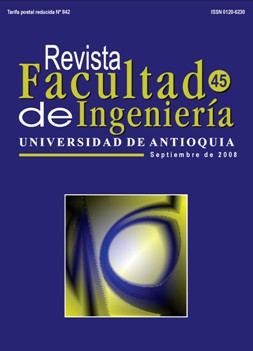Design of the Automatic System for an Electroplating Pilot Plant. Part I: Hierarchical Petri Nets Model
DOI:
https://doi.org/10.17533/udea.redin.18114Keywords:
Hierarchical Petri nets, Formal methods, Automation, Hierarchic and modular design, ElectroplatingAbstract
The description of the design and automation of a hard nickel electroplating pilot plant using rectangular pulse current is presented. For the automation of this process the Petri nets (PN) are described and used, starting from their more basic form and justifying why to use higher levels of abstraction or extensions of the same ones. These levels include the IPN (Interpreted PN), HPN (Hierarchical PN) and, finally, as a complement to this article the use of the HCPN (Hierarchical Colored PN). The results are reflected in the reduction of the pattern complexity due to the properties of modularization of the nets of higher level.
Downloads
References
G. Frey, L. Litz. “Formal methods in PLC programming”. Proceedings of the IEEE conference on System Man and Cybernetics. 2000. pp. 2431-2436.
M. Silva. Las Redes de Petri en la Automática y la Informática. Editorial AC. Madrid. 1985. pp. 30-62.
T. Murata. “Petri Nets. Properties, Analysis and Applications”. Proceedings of the IEEE. Vol. 77. 1989. pp. 541-580. DOI: https://doi.org/10.1109/5.24143
G. Frey. “Hierarchical design of logic controllers using signal interpreted Petri nets”. Proceedings of the IFAC AHDS 2003, Saint-Malo (France). 2003. pp. 401-406.
L. Ben-Naoum, R. Boel, L. Bongaerts, B. De Sclmt¬ter, Y. Peng, P. Valckenaers, J. Vandewalle, V. Wertz. “Methodologies for discrete event dynamic systems: A survey”. Journal A. Vol. 36. 1995. pp. 3-14.
E. Park, D. Tilbury, P. Khargonekar. “A Modeling and Analysis Methodology for Modular Logic Controllers of Machining Systems using Petri Net Formalism”. IEEE Transactions on Systems, Man, and Cybernetics-C. Vol. 5. 2000. pp. 3201 – 3206.
S. Klein, G. Frey, M. Minas. PLC “Programming with Signal Interpreted Petri Nets”. Applications and Theory of Petri Nets 2003, 24th International Conference, Eindhoven. Springer LNCS 2679. 2003. Vol. 2679. pp. 440-449. DOI: https://doi.org/10.1007/3-540-44919-1_27
R. Beard, G. Saridis. (1993). “A Cost Measure for Efficient Scheduling in Intelligent Machines”. Proceedings of the 1993 IEEE International Symposium on Intelligent Control. 1993. pp. 52-57. DOI: https://doi.org/10.1109/ISIC.1993.397724
G. Frey. “Hierarchical design of logic controllers using signal interpreted Petri nets”. Proceedings of the IFAC AHDS 2003, Saint-Malo (France). 2003. Vol. 12. pp. 401-406.
K. Jensen. Coloured Petri Nets. Basic Concepts, Analysis Methods and Practical Use. Ed. Springer-Verlag. New York. Vol 1. 1997. pp. 89-119.
G. Zapata, J. Branch, L. Quintero. “Metodología para el Modelado y Generación de Código de Control de Sistemas Secuenciales mediante Redes de Petri Jerárquicas”. Revista Avances en Sistemas e informática. Vol. 4. 2007. pp. 59-65.
Downloads
Published
How to Cite
Issue
Section
License
Revista Facultad de Ingeniería, Universidad de Antioquia is licensed under the Creative Commons Attribution BY-NC-SA 4.0 license. https://creativecommons.org/licenses/by-nc-sa/4.0/deed.en
You are free to:
Share — copy and redistribute the material in any medium or format
Adapt — remix, transform, and build upon the material
Under the following terms:
Attribution — You must give appropriate credit, provide a link to the license, and indicate if changes were made. You may do so in any reasonable manner, but not in any way that suggests the licensor endorses you or your use.
NonCommercial — You may not use the material for commercial purposes.
ShareAlike — If you remix, transform, or build upon the material, you must distribute your contributions under the same license as the original.
The material published in the journal can be distributed, copied and exhibited by third parties if the respective credits are given to the journal. No commercial benefit can be obtained and derivative works must be under the same license terms as the original work.










 Twitter
Twitter